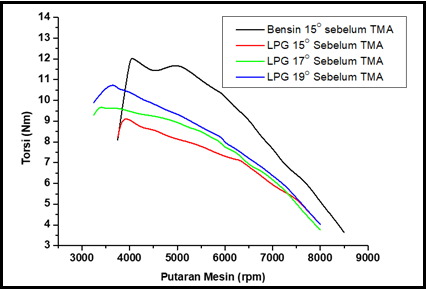Main Article Content
Abstract
Liquefied Petroleum Gas (LPG) is an alternative fuel that has all key properties for the Spark Ignition (SI) engine. However, because of its properties, ignition timing on an LPG SI engine needs to be advanced from the reference angle to get the optimum performance. Therefore, this article presents the torque and power characteristics of a single piston LPG engine on variations of ignition timing. Evaluation of engine performance is carried out at the ignition timing of 15O, 17O, and 19O BTDC. The results showed the highest torque for LPG fuel was 10.64 Nm which was achieved at 3500 rpm with ignition timing of 19O BTDC, while the highest power for LPG fuel was 6.9 hp which was achieved at 5936 rpm with ignition timing of 19O BTDC.
Keywords
Single piston engine
LPG
Ignition timing
Torque
Power
Article Details
References
- M. Y and M. R, “Performance of Single Cylinder Spark Ignition Engine Fueled by LPG,” Procedia Engineering, vol. 53, pp. 579–585, 2013.
- B. Ashok, S. Denis Ashok, and C. Ramesh Kumar, “LPG diesel dual fuel engine - A critical review,” Alexandria Engineering Journal, vol. 54, no. 2, pp. 105–126, 2015.
- WLPGA, “Autogas Incentive Policies,” Neuilly-sur-Seine, 2018.
- R. R. Saraf, S. S. Thipse, and P. K. Saxena, “Comparative Emission Analysis of Gasoline / LPG Automotive Bifuel Engine,” vol. 3, no. 3, pp. 279–282, 2009.
- A. M. Pourkhesalian, A. H. Shamekhi, and F. Salimi, “Alternative fuel and gasoline in an SI engine: A comparative study of performance and emissions characteristics,” Fuel, vol. 89, no. 5, pp. 1056–1063, May 2010.
- B. C. Purnomo, W. Widodo, S. Munahar, M. Setiyo, and B. Waluyo, “Karakteristik Emisi Gas Buang Kendaraan Berbahan Bakar LPG untuk Mesin Bensin Single Piston,” in The 6th URECOL, 2017, pp. 7–12.
- ETSAP, “Automotive LPG and Natural Gas Engines,” © IEA ETSAP - Technology Brief T03, no. April, pp. 1–5, 2010.
- M. Setiyo and B. C. Purnomo, “Investigasi Penurunan Daya Mobil Berbahan Bakar LPG Melalui Pengukuran Efisiensi Volumetrik,” in Seminar Nasional Sains dan Teknologi, 2014, no. November, pp. 1–4.
- M. A. Ã. Ceviz and F. Yu, “Cyclic variations on LPG and gasoline-fuelled lean burn SI engine,” vol. 31, pp. 1950–1960, 2006.
- “World LP Gas Association Autogas Incentive Policies, Neuilly-sur-Seine,” 2012.
- M. Setiyo, B. Waluyo, M. Husni, and D. W. Karmiadji, “Characteristics of 1500 CC LPG fueled engine at various of mixer venturi area applied on Tesla A-100 LPG vaporizer,” Jurnal Teknologi, vol. 78, no. 10, pp. 43–49, 2016.
- N. Homdoung, N. Tippayawong, and N. Dussadee, “Effect of Ignition Timing Advance on Performance of a Small Producer Gas Engine,” International Journal of Applied Engineering Research, vol. 9, no. 13, pp. 2341–2348, 2014.
- Baris Erkus, A. Surmen, M. I. Karamangil, R. Arslan, and C. Kaplan, “Effect of Ignition Timing on the Performance of Lpg Fuelled Si Engine,” Energy Education Science and Technology Part A: Energy Science and Research, vol. 28, no. 2, pp. 889–896, 2012.
- K. Lee and J. Ryu, “An experimental study of the flame propagation and combustion characteristics of LPG fuel,” Fuel, vol. 84, no. 9, pp. 1116–1127, 2005.
- M. Setiyo, B. Waluyo, W. Anggono, and M. Husni, “Performance of Gasoline/LPG Bi-Fuel Engine of Manifold absolute Pressure Sensor (MAPS) Variations Feedback,” ARPN Journal of Engineering and Applied Sciences, vol. 11, no. 7, pp. 4707–4712, 2016.

